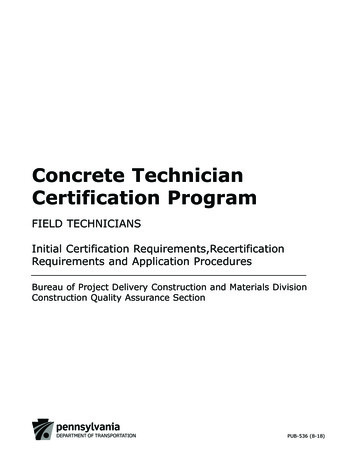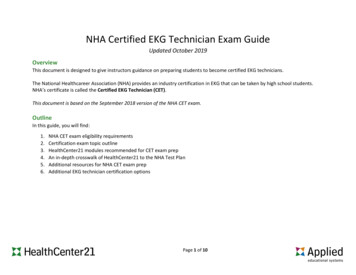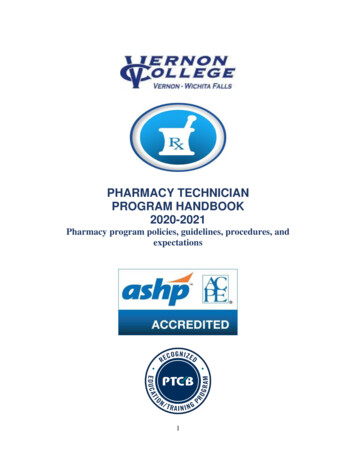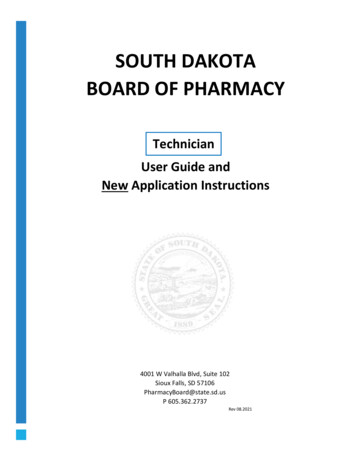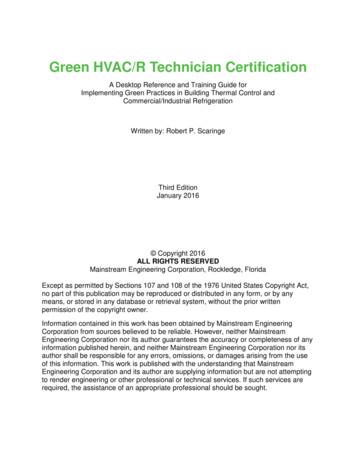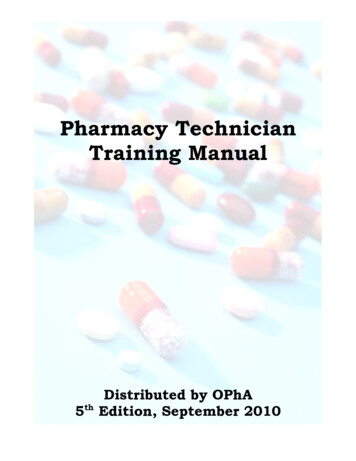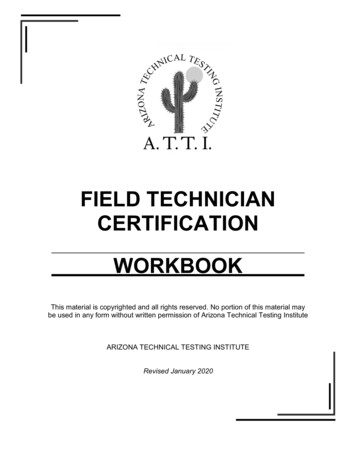
Transcription
FIELD TECHNICIANCERTIFICATIONWORKBOOKThis material is copyrighted and all rights reserved. No portion of this material maybe used in any form without written permission of Arizona Technical Testing InstituteARIZONA TECHNICAL TESTING INSTITUTERevised January 2020
FORWARDThe Arizona Technical Testing Institute (ATTI) is a nonprofit organization formedto promote the highest standard in highway construction materials sampling andtesting through certification of technicians. ATTI certifications emphasize ahands-on approach, that is, applicants must satisfactorily demonstrate testmethods as well as pass a written exam to receive certification.The organization is represented by members from the Arizona Department ofTransportation (ADOT), highway contractors, materials suppliers, materialstesting laboratories, Arizona Rock Products Association (ARPA), FederalHighway Administration (FHWA), and Arizona General Contractors (AGC).ATTI certifications satisfy ADOT and federal requirements which specify thattechnicians performing materials sampling and testing on ADOT projects areproperly qualified.ATTI provides the following certifications:ATTI FIELD TECHNICIAN – field sampling and testing of soils,aggregates, asphalt, and asphaltic concrete,ATTI LABORATORY SOILS/AGGREGATE TECHNICIAN – laboratorysampling and testing of soils and aggregate,ATTI ASPHALT TECHNICIAN – laboratory sampling and testing ofasphaltic concrete.
TABLE OF CONTENTS1.Introduction .12.Performance Examination .13.WrittenExamination .24.Retesting.25.Certification .36.Cancellation or No‐Show .37.Appeals .38.Safety.49.Representative Samples .710. Random Sampling .711. Sampling and Testing Records .1012. Sample Tickets .1013. Test Results .1014. Test Methods .15ARIZ 103Sampling Bituminous Materials. . 16ARIZ 104Sampling Bituminous Mixtures. . 18ARIZ 105Sampling Soils and Aggregates. . 24ARIZ 225, Appendix ACalibration of Proctor Molds. . 32ARIZ 227Rock Correction for Maximum Density andOptimum Moisture Content. . 38ARIZ 229Calibration of Standard Sand and Sand Cone. . 44ARIZ 230Field Density by the Sand Cone Method. . 52ARIZ 232Moisture-Density (One Point Proctor) Method A .62ARIZ 235Field Density by the Nuclear Method. . 72ARIZ 246Moisture-Density (One Point Proctor) Method D .86ARIZ 412Density of Bituminous Mixes by Nuclear Method. . 98AASHTO R76 Reducing Samples of Aggregate to Testing Size. . 102AASHTO T217 Moisture Content by Calcium Carbide Method. . 10815. Appendix A1Rounding Procedure. . 11416. Appendix A2Metric Equivalents & Conversion Factors. . 116
CERTIFICATION INFORMATION SECTIONINTRODUCTIONThe ATTI Field Technician Certification program evaluates the competency ofapplicants performing sampling and testing of soils, aggregates, bituminousmaterials, and apathetic hot mix in the field. Certification is based on satisfactorydemonstration of all specified sampling and testing methods, as well as passinga written examination. Applicants are advised to receive training or haveexperience performing the test methods and calculations before attempting toobtain certification.This workbook provides information regarding the requirements for ATTI FieldTechnician certification, administration of the certification process, and topicscovered during the certification, administration of the certification process, andtopics covered during the certification examinations. Brief coverage is given tosafety issues, plan and profile, representative samples, record keeping, andproperties of soils, aggregates, and asphaltic hot mix. Most importantly, theworkbook contains copies of the applicable testing methods which a certifiedATTI Field Technician must be able to perform.PERFORMANCE EXAMINATIONAs Stated earlier, the emphasis of this certification program is techniciandemonstration of proficiency in performing all test methods which have beenspecified above.Technicians may not use any notes or books while taking the performance exam.The examiner will maintain possession of all examination paperwork.Instead of performing both Method A and Alternate Method D one point proctortests, the examiner may ask the technician to verbally recite the differencesbetween the two tests.The examiner will use standardized checklists to verify proper procedure by thetechnician. During the performance examination, the examiner will indicate atechnician's compliance with each identified item on the individual test methodchecklist with a "Yes" or "No" in the space provided. If any significantdeficiencies are observed during the exam, the examiner must indicate "No" forthat item. Any "No" will constitute failure of that test method. All checklist itemsmust be performed correctly or the test method is considered failed.1
Once completed, the examiner will inform the technician if the test method waspassed or failed. If failed, the examiner will indicate the step or steps that werenot performed properly. The failed test method may be demonstrated a secondtime at the discretion of the examiners. The retest should be performed after allother tests have been completed, the technician has studied the failed testmethod, and the examiner is available. If a test method is failed a second time,the applicant must schedule a retest within 1 year at a cost of 50.00.If the technician requests to start over a test method once they have begun, theexaminer will allow the technician to restart the test method and disregardfindings of the incomplete test. The technician will be allowed to restart a testmethod one time only.If the technician has successfully attained an A TII Asphalt, Soils I Aggregate, orField Technician Certification within the last 12 months you may receive credit forsome of the test methods performed included in that certification.It is recommended that technicians perform all test methods during anexamination period. Any test methods not performed will be consideredfailed.WRITTEN EXAMINATIONThe written examination has a 3 hour time limit to complete. The questions andcalculations are derived directly from the previously mentioned test methods andfrom information presented in the first few chapters of this manual. Eighty (80)percent of the written examination questions must be answered correctly and allcalculations performed correctly to achieve a passing score.Notes and books may not be used while taking the written examination. Theexaminer will maintain possession of all examination paperwork.RETESTINGIf a technician fails to successfully demonstrate a test method as prescribed, thetechnician may be allowed to demonstrate the failed test method a second timeduring the same examination period at the discretion of the examiners. The retestshould be performed after all other tests have been completed, the technicianhas studied the failed test method, and the examiner is available. Failed testmethods must be re-demonstrated within twelve months of the originalexamination date. All retesting is at the discretion of the examiners.A technician failing the written or calculations examination is required to retakethe entire written or calculations examination within twelve months of the originaltest date.2
If a technician fails the performance and /or written examinations a second time,a fee will be charged for additional testing that must be performed within twelvemonths of the original examination date. If the failed items are not successfullypassed the third try, the technician will be required to register and retake theentire certification examination.CERTIFICATIONTo receive certification, the technician must successfully demonstrate all testmethods as well as correctly answer at least 80 percent of the written examquestions and correctly perform all calculations. Certification is granted for aperiod of five years. Successful completion of the entire examination program isrequired for re-certification.CANCELLATION OR NO-SHOWThe cancellation policy is detailed in the ATTI Administration Manual which isavailable on the ATTI website at www.attiaz.org.APPEALSATTI certification examinations, policies, procedures, requirements, andmaterials are developed through a cooperative effort of the ATTI technicaladvisory board and industry experts. The ATTI Board of Directors approves andprovides oversight of the certification program. If a technician feels that thecertification exams have not been correctly administered or if the techniciandesires to appeal their exam scores, they may do so.Appeals should be made in the following sequence:1.2.3.4.Senior ExaminerExecutive DirectorTechnical Advisory BoardATTI Board of DirectorsIf there is not consensual resolution at any level, the technician may escalatetheir appeal to the next level. The decision of the Board of directors is final.Technicians are encouraged to provide feedback to ATTI on any portion of theexaminations, manual content, exam administration, or requirements of the ATTIcertification process. The comments received will be discussed by the technicaladvisory board and, if merited, revisions to the program will be initiated.3
TECHNICAL SECTIONSAFETYSome of the test methods in this manual may involve hazardous materialsoperations, and/or equipment. This manual does not claim to address all relevantsafety issues which may be encountered or which may be associated with its useor with the performance of test procedures introduced here. It is the responsibilityof the technician to determine, establish, and follow appropriate health and safetypractices. The technician must also determine the applicability of any regulatorylimitations of test equipment and chemicals.THE OCCUPATIONAL SAFETY AND HEALTH ADMINISTRATION (OSHA)OSHA has established safety requirements for individuals working in variousenvironments. In the field and laboratory these requirements include suchmeasures as wearing hard hats, eye protection, and protective footwear as wellas the need to observe certain precautions when operating machinery and otherequipment. There are also regulations pertaining to the handling and storage ofchemicals, nuclear devices, and other hazardous materials. This short discussionon safety is not meant to preclude or to include OSHA requirements. It is up tothe individual technician to be acquainted with OSHA regulations thatapply to their particular job assignment.4
PLAN AND PROFILEThe plan and profile of a specific segment of a roadway are typically printed on asingle sheet of the project plans with the plan view at the top of the sheet and thecorresponding profile view at the bottom of the sheet. Plan and profiles aredrawn such that profile stationing is directly below the plan stationing. SeeFigure 1.The plan shows an aerial view of the roadway, as if the observer is lookingdirectly down on the roadway. Roadway details such as horizontal alignment,roadway width, right-of-way, and structure locations are illustrated on the plansheet relative to the roadway centerline. The profile shows a longitudinal crosssection view of the roadway elevation, taken through the centerline of theroadway. The profile illustrates details such as vertical alignment of thecenterline, existing ground line elevation, culvert elevation, and structureelevations.PLAN DETAILSThe centerline, denoted, is the surveyed center of the roadway. It may bean existing centerline or a newly established centerline. If both are illustrated,they should be clearly identified.Station numbers are established along the centerline. Each station represents100 feet; therefore, a distance of 700 feet is equivalent to 7 stations. Mostprojects will begin at station 0 00 and increase in stationing to the end of theproject. For example, the location of a culvert is given as Station 21 76.8 whichis equal to 2,176.8 feet from the beginning of the project. When a new centerlineis established, and it is desired that the new stationing match the old, it is oftennecessary to add a correction equation.Sampling of roadway materials is conducted randomly; consequently, very fewsamples are taken on the centerline. Specific sample locations are identified bystation and centerline offset to the left of centerline or to the right of centerline.As an individual is facing in the direction of increasing stationing, the individual'sleft defines "left of centerline" and the individual's right defines "right ofcenterline."5
PROFILE DETAILSElevations of various roadway centerline details are illustrated on the profilesheet. The elevations represent vertical distance above or below sea level.The existing ground elevation along the centerline and the design finishedroadway centerline are illustrated by lines drawn at the appropriate elevations.The top elevation and depth of a sample is often drawn on the profile sheet.TYPICAL SECTIONSTypical sections illustrate the components and dimensional requirements ofeach pavement structure used on the project. The typical pavement sections arecross-sections taken transversely across the roadway. See Figure 2.Pavement structural sections provide details on the material type and depth ofeach layer of the pavement structure. The pavement structure includes allpavement materials placed above the subgrade, including aggregate subbase,aggregate base, asphaltic concrete, Portland cement concrete, and asphalticconcrete friction course.6
REPRESENTATIVE SAMPLESAs should be apparent, acceptance or rejection of materials is highly dependenton the representativeness of a small sample that is tested to determine thequality of a large quantity of material. If the sample is not truly representative ofthe larger quantity, acceptable material might be rejected or unacceptablematerial might be accepted. Unbiased samples must be obtained in a way thatthe true nature of the material is represented. For example, aggregate stockpilesshould not be sampled at the surface where coarser slough material is present.Similarly, all material from an asphaltic concrete plate sample should be obtainedwith single strokes of the sampling device through the middle of the plate,excluding material that sloughs onto the plate after initial sampling.RANDOM SAMPLINGA random sample is any sample which has an equal chance as any other sampleof being selected from a population. In other words, there is an equal chance forall locations and all fractions of materials to be sampled.Samples should not be obtained on a predetermined basis or based on thequality of the material in a certain area. If sampling is not performed on arandom basis, the quality of the sample can be artificially modified and thesample will no longer be representative of the larger quantity.When a sample is not representative, it is said to be biased. Examples of biasedsampling that should not be used include sampling a roadway at a given intervalsuch as 1500 feet; sampling asphaltic concrete production at a given frequency,such as every 500 tons; or taking samples at a given time, such as every hour onthe hour.Random sampling is usually accomplished with the use of random numbergenerators or tables of random numbers. Most calculators and computerscontain a random number generator that merely requires the operator to hit abutton. The automated random number generators use programmed tables ofrandom numbers similar to the table shown in figure 3. Random number tablesare simply random arrangements of numbers of any table length.72.99.68.03.70.167.51.13.40.96.28.53.98 .45 .01 .55 .25 .24.69 .59 .88 .35 .07 .66.08 .83 .11 .48 .56 .19.49 .10 .74 .38 .22 .87.04 .63 .27 .15 .60 .44.85 .09 .39 .91 .47 .30Figure 3. Table of random Numbers.73.82.46.33.03.77.43.78.31.57.37.42
ASTM D3665 - "Standard Practice for Random Sampling of ConstructionMaterials" is a reference used by the industry for determining random locations ortiming at which samples of construction materials are to be taken. The ASTMmethod uses a table of random numbers and details the procedures fordetermining random times for belt sampling, random lengths for windrowsampling, random sampling of in-place paved materials, and random truck loadnumber sampling.To obtain a group of random numbers, select a starting number in a randomnumber table, never repeating the same starting number, and proceed from thestarting number reading left to right, top to bottom, bottom to top, right to left ordiagonally. Each number will then correspond to a sampling frequency.Example 1:Four samples are required for a 12 feet wide pavement with a lot sizedetermined to be 4000 linear feet. The lot begins at station 100 00. Usethe random number table in Figure 3 to determine the sample locations.Step 1, from the given information:Lot begins at station 100 00Lot ends at station 140 00Length of lot 4,000 feetStep 2, determine the sample location:Using the random number table, obtain two sets of 4 randomnumbers each.Set 1 will be used to determine stationing (X) of the samplesby multiplying the random numbers by 4,000 feet.Set 2 will be used to determine the sampling distance fromthe right edge of pavement (Y) by multiplying the random numbersby 12 feet.Step 2a, random numbers chosen from table:Set 1: .13Set 2: .73.69.82.59.46.88.33Step 2b, sample coordinate locations determined:Sample #1:X .13 X 4000 520 feetY .73 X 12 8.8 feet8
Sample #2:X .69 X 4000 2760 feetY .82 X 12 9.8 feetSample #3:X .59 X 4000 2360 feetY .46 X 12 5.5 feetSample #4:X .88 X 4000 3520 feetY .33 X 12 4.0 feetStep 2c, samples located by stationing and offset:Sample #1:Station 100 00 520 feet Station 105 20 @ 8.8feet from right edge of pavementSample #2:Station 100 00 2760 feet Station 127 60 @ 9.8feet from right edge of pavementSample #3:Station 100 00 2360 feet Station 123 60 @ 5.5feet from right edge of pavementSample #4:Station 100 00 3520 feet Station 135 20 @ 4.0feet from right edge of pavementWhen obtaining samples from a large area (or lot), divide the area into sublots ifnecessary and obtain samples from each sublot using stratified randomsampling. Stratified random sampling assures that samples are taken fromthroughout the entire lot and are not concentrated in one area of the lot. SeeFigure 4.1234LOTFigure 4. Sublots for stratified sampling.9
SAMPLING AND TESTING RECORDSAll data collected during the sampling and testing processes should bedocumented electronically or retained on paper. This documentation provides: Records pertaining to individual samples.A process to trace samples and test results.Control of samples as they are processed and tested.Who did the sampling and testing.What testing was done.Permanent record of test data and test results.Sample tickets used for sample identification, work instruction cards directingwhich tests to perform, logs of samples and tests performed, test dataworksheets, and test result reporting forms are all routinely used records which atechnician must have familiarity.Test methods provided in AASHTO Standard Specifications, Part I/tests and inthe ADOT Materials Testing Manual define which data to collect, calculations toperform, and what information to report. They also have guidelines fordetermining if test results are reasonable.SAMPLE TICKETSSample tickets need to be attached to or accompany all samples. A sampleticket is the document which identifies an individual sample. Sample tickets willusually contain information such as: Project number or code.Name of the person who obtained sample.Type of material.Date and time the sample was obtained.Purpose of the sample.Where the sample was takenSample number.Type of testing to be performed.TEST RESULTSField sampling and testing must always be done according to test methods.Precise and reliable sampling and testing directly impacts the acceptance andpayment of a product. If sampling and testing are not performed correctly, asubstandard product could be accepted at full compensation or an acceptableproduct could be rejected. Test methods used most frequently are contained inthe ADOT Materials Testing Manual and the AASHTO Standard Specifications,10
Part II, Tests. These methods describe how large a sample should be, step-bystep procedures, what data is to be collected, what calculations are to beperformed, and what test results are reported.The reliability of testing is often checked with the use of split samples which aretested by two different technicians. If individual test results or the comparison ofsplit samples do not seem reasonable, an investigation should be conducted toestablish why. Usually the discrepancy will be due to procedural or equipmentdeficiencies, errors in calculations, incorrect transposition of data, or the use ofprocedural shortcuts. Poor equipment calibration or equipment malfunction andimproper handling of samples can also cause unreliable test results. Retestingshould be performed only after the discrepancies have been corrected.Occasionally, an unreasonable test result may be encountered. Unreasonabletest results should not simply be labeled as outliers and discarded. Resultsshould only be discarded if they are outside of the range of possible results or ifthey are determined statistically to be outliers. ASTM E178 gives a commonmethod for determining outliers in the highway construction industry.All test reports should clearly identify the individual who performed the test andthe date the test was completed. Test reports should also include the signatureof the individual taking responsibility for the validity of the testing. All revisionsmade to a test report must identify the person making the changes and the datethe changes were made. Example copies of test report forms are included insome of the test methods presented in this workbook.11
MATERIALS PROPERTIESSpecific strength, durability, water dispersion and other similar properties of soils,aggregates, and asphaltic concrete are the basic properties a highwayconstruction material is designed to satisfy. The soils and aggregate propertiesof interest to the field testing technician are briefly discussed below. Compactiontesting and sampling of mixtures for laboratory testing are the items of asphalticconcrete construction that are of primary interest to the field technician involvedwith sampling and testing.ENGINEERING PROPERTIES OF SOILSSelected characteristics of soils directly influence the design, construction, andperformance of highway features. The properties of soils on a constructionproject determine the slope of a cut, the load bearing capacity of a subgrade andthe sheer strength of embankments. Soils as well as aggregate base coursesmust have enough strength to support the applied loads of traffic, embankments,and structures under all climatic conditions. Two tests commonly used todetermine the strength properties of a subgrade or embankment are thegradation and plasticity index test. These properties directly influence the soilsupport value of the subgrade under the pavement structure. The plasticity indexis an indication of the cohesiveness, bonding, and moisture susceptibility of asoil.For the purposes of this course, the engineering properties of three major soiltypes will be considered. Engineering properties for our use will refer to theproperties of these soil types as they relate to highway design and construction.These three main soil types consist of:Granular soils-Sands and gravelsFine-grained soils- silts and claysOrganic soils - organic clays and organic peat.Granular soils, when free draining are not susceptible to frost and will settlequickly under a load. These characteristics make granular soils a good choicefor use in foundations, embankments, and as wall backfill material. Thedrawback to the use of granular soils is that due to their high permeability it canbe difficult to dewater them.Cohesive soils are fine-grained soils. They sometimes possess low shearstrength and are compressible and plastic. Wetting of these soils results in afurther reduction of shear strength and also in expansion. The expansion will befollowed by shrinkage as the material dries. Shear strength is also lost when acohesive soil is disturbed. These soils can be subject to landslides. Cohesivesoils are usually considered a poor choice for construction materials.12
Organic refers to decayed animal and vegetable materials. Therefore an organicsoil is any soil containing enough organic material to influence the properties andcharacteristics of the soil. In general, organic soils are not used in highwayconstruction. All soils, which contain an organic component, should be reviewedcarefully and with suspicion when used in highway construction. The presenceof organic material in the soils results in an increase in compressibility and areduction of load bearing capacity. Organic materials can also contain toxicgases, which are released when the soil is disturbed.ENGINEERING PROPERTIES OF AGGREGATESParticle size and shape, gradation, and cleanliness are three important propertiesof aggregates that are considered in highway construction. These threeproperties directly influence the capability of an aggregate mixture to compact,drain water, and adhere to binders.Aggregate particles are sieved through screens to obtain portions of the sameparticle size. Percentages of the different sizes are then combined to createengineered base, bedding, backfill, and mineral aggregate composites. Particleshape also influences the compactibility and surface to surface contact ofaggregates. Angular and irregular particles interlock and resist displacementmuch better than rounded particles.Particle shape also influences the compactibility and surface to surface contactof aggregates. Angular and irregular particles interlock and resist displacementmuch better than rounded particles. Particle shapes of interest include irregular,angular, flaky, elongated and rounded. Elongated particles have a longdimension which is 1.8 times the average dimension and flaky particles are thosewhose shortest dimension is less than 0.6 times the average dimension. Each ofthese shapes is determined by test methods contained later in this manual.Gradation defines the distribution of a variety of aggregate particle sizes and isoften referred to as aggregate grading. The intended use for the aggregate willdetermine the percentage of each particle size to be used in the gradation or sizedistribution. Plant screening and crushing processes are used to controlgradation. Sieve analyses (ARIZ 201) are performed on an aggregate mixture todetermine the true percentage of each size in the mixture.ENGINEERING PROPERTIES OF ASPHALTIC CONCRETEField sampling of asphaltic concrete mixes is performed to check the producedmix properties for compliance with mix design requirements. Asphaltic concretemixture performance is affected by the mineral aggregate properties and liquidasphalt cement properties. Consequently, it is important that representativesamples are taken. The common method for sampling asphaltic concrete mats isto place a 1’ x 4’ metal plate in front of the paver. As the paver travels across the13
plate, material is placed on the plate. When obtaining the asphaltic concretesample from the surface of the plate, all slough material from the sides of the cutof the surface should not be collected.Asphaltic concrete samples are typically tested for aggregate gradations, voidproperties, and asphalt cement content. These properties directly influence themix's ability to resist deformation, cracking, and failure from the loads placed bythe traffic and effects of weather.Asphalt cements function as a binder, or glue, which hold the aggregate particlestogether and provide protection against the effects of water. Liquid asphaltcement samples are taken to check viscoelastic, temperature sensitivity andaging properties.COMPACTIONAsphaltic concrete, soils and aggregate bases, backfills and beddings aretypically compacted to a specified percentage of maximum density in the field byuse of rollers or mechanical compactors. Maximum compaction is desirable toreduce settling and deformation, and increase load bearing capacity. Thedensity of a layer of in-place soils/aggregate material is checked by the sandcone density test (ARIZ 230), nuclear density gauge (ARIZ 235), or one-pointproctor test (ARIZ 232, ARIZ 246). Asphaltic concrete compaction is checkedwith th
examiner will allow the technician to restart the test method and disregard findings of the incomplete test. The technician will be allowed to restart a test method one time only. If the technician has successfully attained an A TII Asphalt, Soils I Aggregate, or Field Technician Certification within the last 12 months you may receive credit for
